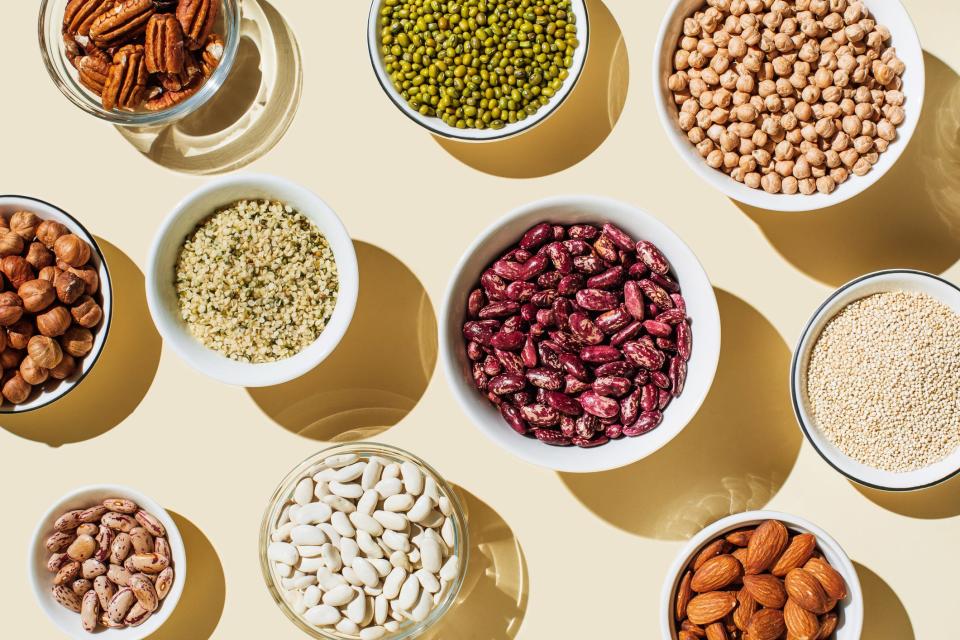-
Nutrition expert Tim Spector said that most people get enough protein, but not fiber.
-
He recommended people focus on increasing the amount of fiber they eat each day.
-
His tips include switching meat for beans and eating different types of plant-based protein.
Protein-enriched foods such as cereal bars, energy drinks, and pasta have taken over grocery store shelves as consumers try to up their protein consumption. But a top nutrition scientist says that we’re focusing on the wrong macronutrient.
More than half of Americans meet or exceed the minimum daily requirement of protein — 0.36 grams of protein per pound of body weight each day — according to the US Department of Agriculture’s Dietary Guidelines for Americans 2020-2025.
Yet the Guidelines said more than 90% of women and 97% of men in the US don’t meet the recommended intakes for dietary fiber.
Advertisement
Advertisement
Tim Spector, a British epidemiologist and cofounder of the nutrition company ZOE, told Business Insider that people should focus more on increasing their fiber intake than protein if they’re aiming for a healthier diet. Fiber is great for gut health, can improve heart health, and can help ease constipation, BI previously reported.
Other health practitioners may not agree with Spector’s call to prioritize fiber. Rosa Becerra-Soberon, a registered dietitian at Top Nutrition Coaching, told BI that the main goal should be focusing on a well-balanced diet with enough fiber and protein.
Spector shared three tips on how to hit your protein intake goals while getting enough fiber as part of a healthy diet.
Prioritize natural protein sources

Spector recommends swapping meat out for plant-based protein sources, such as beans, legumes, and nuts.Tanja Ivanova/ Getty
Spector doesn’t eat meat often but wrote in his cookbook, released in the US in 2025, that he still gets around 1 gram of protein per kilogram of his body weight per day, mostly from plants and whole foods
Advertisement
Advertisement
While plant-based protein sources tend to contain less protein than meat, they contain more fiber. According to the US Department of Agriculture, 100 grams of fried tofu contains about 18 grams of protein and 4 grams of fiber.
Becerra-Soberon said that if you don’t consume meat, you should make sure you get all the essential amino acids by eating grains and seeds.
Swap meat for beans and lentils
Spector wrote that replacing meat with legumes is a great way to increase your fiber intake while meeting your protein needs. Legumes like beans and lentils are protein-heavy, but higher in fiber and better for the environment than meat.
For example, canned chickpeas contain about 8 grams of protein per 100 grams, as well as 7 grams of dietary fiber. Chicken has 22 grams of protein per 100 grams, but no fiber, according to USDA data — and tends to be more expensive than chickpeas.
Advertisement
Advertisement
More in Health
Longevity researcher Dan Buettner previously shared dietitian-approved recipes for cooking with legumes with BI.
Variety is key
Because plants generally contain less protein than meat, Spector wrote that he incorporates “a good mix” of plant-based protein sources into his diet throughout the day. This is because different whole foods contain different amounts of protein, so you might have to eat a “variety of nutrient-dense whole foods to take care of your protein needs,” he wrote.

Spector eats yogurt with fruit, nuts, and seeds for breakfast.Anne DEL SOCORRO/Getty Images
For example, Spector’s go-to breakfast of yogurt, kefir, berries, nuts, and seeds contains about 30 grams of protein from multiple sources. He might also have butter beans with quinoa for lunch and a portion of tofu for dinner, he said.
His colleague at ZOE, Dr. Will Bulsiewicz, previously shared his favorite bean chili recipe, which he eats for lunch every day. The recipe includes beans and farro, both of which are good sources of protein and fiber.
Advertisement
Advertisement
Becerra-Soberon also recommended little additions of protein throughout the day, such as sprinkling hemp seeds on meals, which contain 31 grams of protein and 4 grams of fiber per 100 grams, or eating almond butter as a snack, which contains about 21 grams of protein and 10 grams of fiber per 100 grams.
While eating healthily can be more expensive, BI has previously reported on how to eat healthily on a budget.
Read the original article on Business Insider
EMEA Tribune is not involved in this news article, it is taken from our partners and or from the News Agencies. Copyright and Credit go to the News Agencies, email news@emeatribune.com Follow our WhatsApp verified Channel





